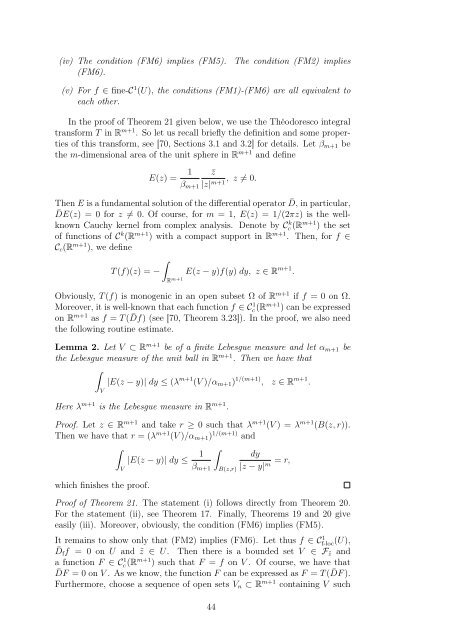Hypercomplex Analysis Selected Topics
Hypercomplex Analysis Selected Topics
Hypercomplex Analysis Selected Topics
You also want an ePaper? Increase the reach of your titles
YUMPU automatically turns print PDFs into web optimized ePapers that Google loves.
(iv) The condition (FM6) implies (FM5). The condition (FM2) implies<br />
(FM6).<br />
(v) For f ∈ fine-C 1 (U), the conditions (FM1)-(FM6) are all equivalent to<br />
each other.<br />
In the proof of Theorem 21 given below, we use the Théodoresco integral<br />
transform T in R m+1 . So let us recall briefly the definition and some properties<br />
of this transform, see [70, Sections 3.1 and 3.2] for details. Let βm+1 be<br />
the m-dimensional area of the unit sphere in R m+1 and define<br />
E(z) = 1<br />
βm+1<br />
¯z<br />
, z = 0.<br />
|z| m+1<br />
Then E is a fundamental solution of the differential operator ¯ D, in particular,<br />
¯DE(z) = 0 for z = 0. Of course, for m = 1, E(z) = 1/(2πz) is the wellknown<br />
Cauchy kernel from complex analysis. Denote by Ck c (Rm+1 ) the set<br />
of functions of Ck (Rm+1 ) with a compact support in Rm+1 . Then, for f ∈<br />
Cc(Rm+1 ), we define<br />
<br />
T (f)(z) = − E(z − y)f(y) dy, z ∈ R m+1 .<br />
R m+1<br />
Obviously, T (f) is monogenic in an open subset Ω of R m+1 if f = 0 on Ω.<br />
Moreover, it is well-known that each function f ∈ C 1 c (R m+1 ) can be expressed<br />
on R m+1 as f = T ( ¯ Df) (see [70, Theorem 3.23]). In the proof, we also need<br />
the following routine estimate.<br />
Lemma 2. Let V ⊂ Rm+1 be of a finite Lebesgue measure and let αm+1 be<br />
the Lebesgue measure of the unit ball in Rm+1 . Then we have that<br />
<br />
|E(z − y)| dy ≤ (λ m+1 (V )/αm+1) 1/(m+1) , z ∈ R m+1 .<br />
V<br />
Here λ m+1 is the Lebesgue measure in R m+1 .<br />
Proof. Let z ∈ R m+1 and take r ≥ 0 such that λ m+1 (V ) = λ m+1 (B(z, r)).<br />
Then we have that r = (λ m+1 (V )/αm+1) 1/(m+1) and<br />
<br />
which finishes the proof.<br />
V<br />
|E(z − y)| dy ≤ 1<br />
βm+1<br />
<br />
B(z,r)<br />
dy<br />
= r,<br />
|z − y| m<br />
Proof of Theorem 21. The statement (i) follows directly from Theorem 20.<br />
For the statement (ii), see Theorem 17. Finally, Theorems 19 and 20 give<br />
easily (iii). Moreover, obviously, the condition (FM6) implies (FM5).<br />
It remains to show only that (FM2) implies (FM6). Let thus f ∈ C 1 f-loc (U),<br />
¯Dff = 0 on U and ˜z ∈ U. Then there is a bounded set V ∈ F˜z and<br />
a function F ∈ C 1 c (R m+1 ) such that F = f on V . Of course, we have that<br />
¯DF = 0 on V . As we know, the function F can be expressed as F = T ( ¯ DF ).<br />
Furthermore, choose a sequence of open sets Vn ⊂ R m+1 containing V such<br />
44

















